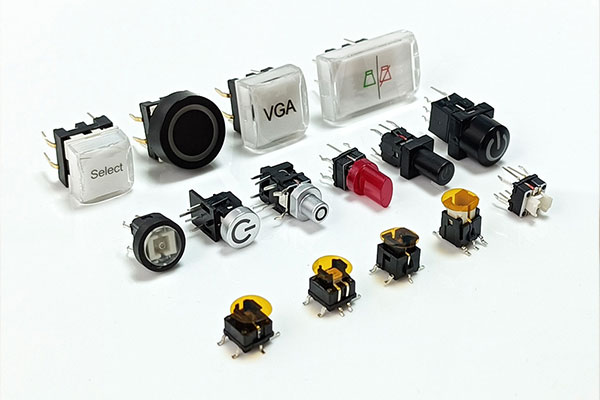Knowledge
The difference of tact switch and illuminated tact switch
Tact switches and illuminated tact switches are two variations of a common electronic component used in various applications, particularly in consumer electronics, automotive devices, industrial control systems, and more. While they serve a similar purpose, there are key differences between them in terms of functionality, design, and applications.

Tact Switch:
Tact switches, also known as tactile switches or momentary switches, are electromechanical devices designed to provide tactile feedback when pressed. They are typically small, low-profile switches that are manually operated by pressing on their actuator button. Tact switches are widely used in electronic devices where a user input is required, such as keyboards, remote controls, and control panels.
These switches consist of several components including a housing, actuator button, contacts, and a mechanism to provide tactile feedback. When the actuator button is pressed, it compresses a spring or dome-shaped component, which in turn pushes metal contacts together to complete an electrical circuit. This action generates a tactile sensation, indicating to the user that the switch has been activated.
Tact switches come in various configurations, including surface-mount and through-hole types, and are available in different sizes, actuation forces, and lifecycles to suit different application requirements.
Illuminated Tact Switch:
Illuminated tact switches, as the name suggests, are a type of tact switch that incorporates built-in illumination. They are equipped with LED (Light Emitting Diode) or other light sources to provide visual feedback when the switch is activated. The illumination can serve different purposes such as indicating the switch's status (on/off), highlighting its location in dimly lit environments, or adding aesthetic appeal to the device.
These switches are commonly used in applications where visual indication is crucial, such as in control panels, gaming peripherals, automotive dashboard controls, and appliances. The integration of illumination adds another layer of functionality and enhances the user experience by providing clear visual feedback.
The design of illuminated tact switches includes additional components such as LEDs, light guides, and diffusers to evenly distribute light across the actuator button or surrounding area. The LEDs are usually connected to the switch's electrical circuit in parallel with the main contacts, allowing them to illuminate when the switch is activated.
Key Differences:
1. Functionality: The primary difference between tact switches and illuminated tact switches lies in the presence of illumination. While tact switches provide tactile feedback through physical sensation, illuminated tact switches offer both tactile and visual feedback through built-in illumination.
2. Design: Illuminated tact switches have a more complex design compared to standard tact switches due to the integration of LEDs and additional light-guiding components. This may result in slightly larger dimensions and increased complexity in assembly.
3. Applications: Tact switches are suitable for applications where tactile feedback is sufficient, whereas illuminated tact switches are preferred when visual indication is required or desired. The latter finds applications in environments with low ambient light or where the user needs clear feedback about the switch's status.
In conclusion, while both tact switches and illuminated tact switches serve as user input devices in electronic systems, the addition of illumination in the latter enhances their functionality and applicability in various scenarios, making them a preferred choice for certain applications where visual feedback is essential.
RELATED NEWS
- Can a metal button switch be integrated with indicator lights 2025-12-08
- The difference between a momentary and a latching metal button switch 2025-12-08
- What size is the broadcasting illuminated push button 2025-12-03
- Video illuminated push button 2025-12-03
- Are DIP switches still widely used nowadays 2025-11-03
CATEGORIES
LATEST NEWS
CONTACT US
Contact: Bella
Phone: 15999819066
E-mail: rucoe@rucoe.com
Whatsapp:+86-15999819066
Add: Taoyuan Street, Nanshan, Shenzhen
